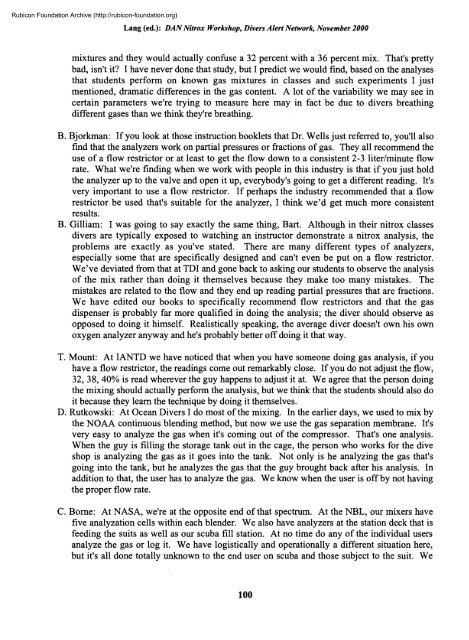Nitrox workshop dings - Divers Alert Network
Nitrox workshop dings - Divers Alert Network
Nitrox workshop dings - Divers Alert Network
You also want an ePaper? Increase the reach of your titles
YUMPU automatically turns print PDFs into web optimized ePapers that Google loves.
Rubicon Foundation Archive (http://rubicon-foundation.org)Lang (ed.): DAN<strong>Nitrox</strong> Workshop, <strong>Divers</strong> <strong>Alert</strong> <strong>Network</strong>, November 2000mixtures and they would actually confuse a 32 percent with a 36 percent mix. That's prettybad, isn't it? I have never done that study, but I predict we would find, based on the analysesthat students perform on known gas mixtures in classes and such experiments I justmentioned, dramatic differences in the gas content. A lot of the variability we may see incertain parameters we're trying to measure here may in fact be due to divers breathingdifferent gases than we think they're breathing.B. Bjorkman: If you look at those instruction booklets that Dr. Wells just referred to, you'll alsofind that the analyzers work on partial pressures or fractions of gas. They all recommend theuse of a flow restrictor or at least to get the flow down to a consistent 2-3 liter/minute flowrate. What we're finding when we work with people in this industry is that if you just holdthe analyzer up to the valve and open it up, everybody's going to get a different reading. It'svery important to use a flow restrictor. If perhaps the industry recommended that a flowrestrictor be used that's suitable for the analyzer, I think we'd get much more consistentresults.B. Gilliam: I was going to say exactly the same thing, Bart. Although in their nitrox classesdivers are typically exposed to watching an instructor demonstrate a nitrox analysis, theproblems are exactly as you've stated. There are many different types of analyzers,especially some that are specifically designed and can't even be put on a flow restrictor.We've deviated from that at TDI and gone back to asking our students to observe the analysisof the mix rather than doing it themselves because they make too many mistakes. Themistakes are related to the flow and they end up reading partial pressures that are fractions.We have edited our books to specifically recommend flow restrictors and that the gasdispenser is probably far more qualified in doing the analysis; the diver should observe asopposed to doing it himself. Realistically speaking, the average diver doesn't own his ownoxygen analyzer anyway and he's probably better off doing it that way.T. Mount: At IANTD we have noticed that when you have someone doing gas analysis, if youhave a flow restrictor, the rea<strong>dings</strong> come out remarkably close. If you do not adjust the flow,32, 38, 40% is read wherever the guy happens to adjust it at. We agree that the person doingthe mixing should actually perform the analysis, but we think that the students should also doit because they learn the technique by doing it themselves.D. Rutkowski: At Ocean <strong>Divers</strong> I do most of the mixing. In the earlier days, we used to mix bythe NOAA continuous blending method, but now we use the gas separation membrane. It'svery easy to analyze the gas when it's coming out of the compressor. That's one analysis.When the guy is filling the storage tank out in the cage, the person who works for the diveshop is analyzing the gas as it goes into the tank. Not only is he analyzing the gas that'sgoing into the tank, but he analyzes the gas that the guy brought back after his analysis. Inaddition to that, the user has to analyze the gas. We know when the user is off by not havingthe proper flow rate.C. Borne: At NASA, we're at the opposite end of that spectrum. At the NBL, our mixers havefive analyzation cells within each blender. We also have analyzers at the station deck that isfeeding the suits as well as our scuba fill station. At no time do any of the individual usersanalyze the gas or log it. We have logistically and operationally a different situation here,but it's all done totally unknown to the end user on scuba and those subject to the suit. We100
















